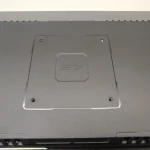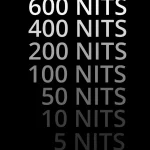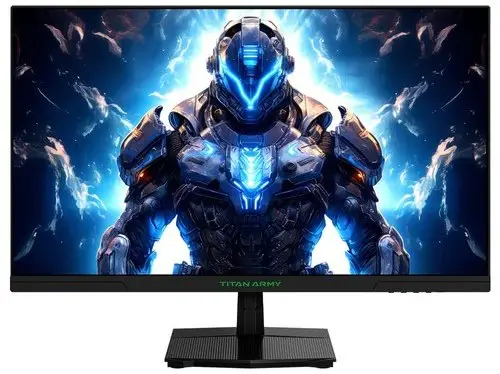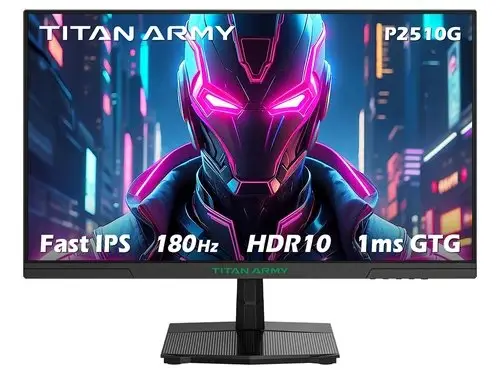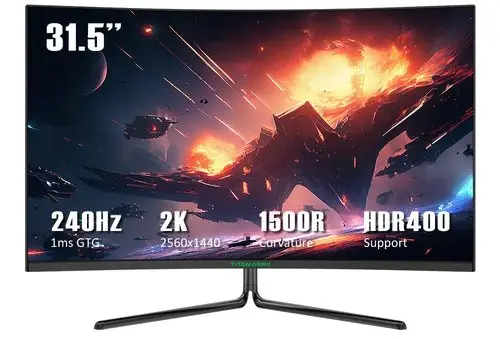Inhalt: [-]
Can the TitanArmy P27GR fulfil its advertising promises and make gamers happy? What about its ergonomics? In this test, I get to the bottom of things.
Transparency
No, the monitor is not transparent. :-) I just want to be open. I received the TitanArmy P27GR from Geekbuying free of charge for testing without having to fulfil any requirements. Many thanks for that.
I actually didn’t want to test any monitors because I didn’t have the necessary equipment. In the meantime, however, I have bought the basic equipment such as a colourimeter, an oscilloscope and a photo probe and have read up on the subject in depth. So I can offer you an objective test. Honesty is the basis of this website.
My setup so far
I’ve had a Swedx 28″ 4K monitor for a few years now. Hand on heart: although this resolution is super sharp, it is not useful for daily work in native resolution on the desktop, as the font is simply too small. I therefore operated the monitor with a 2K resolution. Both with fractional scaling in the operating system and scaling by the monitor itself. However, both types of scaling are blurrier, and scaling by the OS also drastically increases energy consumption. The Swedx does offer AMD’s Freesync, but only 60 Hz. This is not particularly ergonomic when working and the FPS is limited to 60 when gaming.
The TitanArmy with its QHD resolution on 27″ offers a pixel density of 109 PPI, which is a good balance between sharpness and text size for everyday work. I can set the refresh rate to 180 Hz, which enables flicker-free and therefore fatigue-free working. Perfect!
TitanArmy P27GR
The manufacturer specifies the following values:
- 27-inch Fast IPS panel
- WQHD resolution (2560 × 1440 pixels)
- Refresh rate of up to 180 Hz
- ELED backlight with DC Dimming(!)
- G-Sync and FreeSync
- Response time of 1 ms GtG
- Colour space of 120 % sRGB
- Contrast ratio 1,000:1
- 300 nits (typical)
- Equipped with DisplayPort 1.2 and HDMI 2.0
- Picture in Picture mode
- External power supply (12 V, 4 A, maximum 48 watts)
Measured values
I have carried out several series of measurements with the Datacolor Spyder X and DisplayCAL. The TitanArmy P27GR is a true-colour monitor and is therefore also suitable for ambitious hobby image and video editors – which is not primarily expected from a gaming monitor. Top!
Based on my measurements, I can’t quite confirm the manufacturer’s values, but this is absolutely normal, as these values are always determined by the manufacturers under ideal conditions. The TitanArmy does not fail in any way, the values are excellent, especially at this favourable price!
- sRGB: 99 %
- AdobeRGB: 87 %
- P3: 86 %
- NTSC: 82 %
- 307 nits (cd/m²)
- 980:1 contrast ratio
Power consumption
I measured the energy consumption with the Brennenstuhl PM231E, which is one of the better devices.
- 100 % brightness: 35 watts
- 65 % brightness: 25 watts
- Off: 0.1 watt
Interesting: The various game modes do not consume more energy. Usually between 29 and 32 watts.
These values are absolutely within the green range and emphasise that the monitor is both powerful and energy-efficient.
Ergonomics
The enormously high refresh rate of 180 Hz is a treat for the eyes. The picture can be adjusted in a variety of ways and is already sufficiently calibrated in the factory settings. The colour space is also faultless.
Brightness & contrast
I think 300 nits is a reasonable brightness for a monitor in this price range. It should be sufficient for most gaming applications as long as you don’t play in an extremely bright room.
Although „only“ 300 cd/m² is specified, I also set the brightness to 65% during the day, which corresponds to approx. 190 nits. To be able to categorise it: I’m sitting in our bright conservatory!
The contrast ratio is a measured 980:1, which does not contradict the factory specification.
Fortunately, the monitor has DC dimming, which regulates the brightness via the voltage of the power supply. This means the picture is flicker-free. This technology is particularly easy on the eyes, but also more expensive than PWM.(pulse width modulation). Many thanks to TitanArmy for not cutting corners here!
I am one of the few people who clearly notice PWM flickering. But even for people who are not so sensitive, DC dimming is worthwhile if they want to use the monitor for long periods of work.
Brightness distribution
No shadows, spots or similar can be seen with the naked eye. Very good.
The brightness distribution at 100 % brightness looks as follows:
| 244 | 250 | 262 | 250 |
| 264 | 294 | 307 | 299 |
| 266 | 290 | 300 | 297 |
Data in cd/m² (Nits)
Overall, the brightness distribution is really good. The brightest point is 63 cd/m² brighter than the darkest. This corresponds to a deviation of around 20.5 %.
A brightness deviation of 20% is still perfectly okay. You will hardly notice the differences, especially in fast-paced games such as shooters or action titles, because the picture looks good overall and the details are clearly recognisable.
Working
The brightness distribution at 65% brightness (normal working brightness indoors) is as follows:
| 178 | 177 | 182 | 188 |
| 178 | 192 | 203 | 201 |
| 178 | 180 | 197 | 199 |
Data in cd/m² (Nits)
The brightness is between 177 and 203 candela per square metre. It is evenly distributed across the screen, which makes it pleasant to work with.
For hobby users, the maximum brightness deviation is 26 cd/m² (between the brightest point at 203 cd/m² and the darkest at 177 cd/m²), which corresponds to a deviation of around 14.8 %. This is perfectly fine for everyday use and also for gaming.
Viewing angle dependency
If the desk is about 60 cm away, you can hardly see the monitor’s viewing angle dependencies and they are more than okay overall. When you get closer to the screen, the side edges become darker. This is quite normal for flat IPS gaming monitors. Many larger models are therefore curved to minimise such effects.
Stand
The stand is a good standard in this price range. Although it offers a more than adequate forward and backward tilt, is stable and has a cable holder, it unfortunately has neither a height adjustment nor a pivot function. However, it can be removed without tools using a handle.
However, the P27GR has a VESA 100 mount, so you can easily attach it to a monitor arm. :-)
My tip: The Action Market currently offers a very stable dual monitor arm with height adjustment and pivot function for less than 20 EUR. I use this monitor arm myself with the P27GR and am very happy with it.
Workmanship
The workmanship is really top: clean edges, precise gaps and a well thought-out, tool-free mounting system for the stand – you can’t complain.
Design
I really like the design: simple, slim and with pleasantly thin edges. The green accents of the imprints are discreet, so that the monitor also cuts a respectable figure at a workstation. Even the back doesn’t need to hide – no distracting lettering, stickers or oversized nameplates detract from the clean look with sharp edges. In keeping with the company name, the details have a pleasantly sci-fi military feel without being obtrusive. Really well done, TitanArmy!
Frameless design?
Technically, of course, a monitor cannot be completely frameless, but the marketing claim „frameless design“ still applies here. The visible edges including the frame are 7 mm at the top, 8 mm at the sides and 22 mm at the bottom, whereby the actual frame around the panel is only 2 mm thick. This makes the monitor particularly suitable for setups with multiple screens, as they can be placed very close together.
OSD
The OSD (On Screen Menu) is pleasingly easy to operate. Gone are the days when there was space for a large control pad on the front of a CRT monitor. However, TitanArmy has not placed the buttons as (too) close together as other manufacturers, so that for a change I wasn’t constantly making mistakes.
The OSD is playful, no doubt about it, but I think it’s really cool. It has that retro military sci-fi touch in black and green with bevelled edges, which is fun. It’s reminiscent of films like Alien, Starshiptroopers or games like Quake, without being unergonomic.
It is nice that there is a freely assignable hotkey, which is assigned to the brightness setting by default.
Features
As is typical for a gaming monitor, the setting options are very extensive and even include manual RGB colour correction in addition to the usual brightness, contrast and sharpness settings. Numerous modes, including for video, EyeCare, Low Blue Light and Reading Mode, improve ergonomics. The e-book mode (black and white) and the many modes for different game genres are particularly noteworthy!
There are special modes for RTS/RPG, FPS and MOBA.
Yes, great! But what’s the benefit? :-)
RTS/RPG mode
Increases the level of detail of textures and smaller elements. Useful for real-time strategy games (RTS) and role-playing games (RPG) that require a precise representation of landscapes, characters and strategic details. The frame rate is not as crucial here as in action-oriented games, so the focus is more on a visually appealing display.
FPS mode
This mode is ideal for first-person shooters (FPS) and racing games, as it offers fast response times and a higher refresh rate, which means that movements are displayed smoothly and clearly. This reduces motion blur and makes the gameplay much more precise. The use of overdrive also minimises trailing effects and ensures fast, clear movements.
MOBA mode
This mode is optimised for MOBA games (such as League of Legends or Dota 2) to keep important details such as player positions, object descriptions and movements of many units visible at the same time. Less emphasis is placed on extremely high frame rates and more on clarity and attention to detail so that tactical decisions can be made more quickly.
Night mode
Night mode adjusts the brightness and contrast of the screen so that more details can be recognised even in dark areas. This makes enemies hiding in the undergrowth or in shadowy areas more visible. A very useful function!
Customise modes
Great: All modes can be individually customised in detail and a customisable mode (Custom) is available in addition to the default mode! Even ambitious gamers will get their money’s worth here!
AdaptiveSync (VRR)
AdaptiveSync or Variable Refresh Rate (VRR) adjusts the refresh rate of the monitor so that it always corresponds exactly to the frame rate (FPS) delivered by the GPU. For example, if the GPU generates 100 FPS, the monitor frequency is adjusted to 100 Hz. At 144 FPS, the monitor operates at 144 Hz, and the P27GR can even reach up to 180 Hz if the GPU outputs 180 FPS accordingly.
If no AdaptiveSync technology such as FreeSync or G-Sync is used, the GPU and monitor work independently of each other. If the graphics card delivers more or fewer frames per second than the monitor frequency (e.g. 144 Hz), „screen tearing“ may occur. This means that the monitor displays a new image while the GPU is not yet finished with this new image (frame). The result is that parts of the previous and current frame are displayed simultaneously, leading to a visible break and hard edges in the image.
AdaptiveSync adapts the monitor frequency to the FPS of the GPU and thus prevents parts of the previous and current frame from being displayed at the same time. This prevents screen tearing.
Screen tearing despite VRR?
AdaptiveSync only works in a certain range, for example from 48 Hz up to the native refresh rate of the monitor. If the FPS of the graphics card falls below the minimum value, VRR is deactivated and artefacts can occur again. The graphics card is therefore to blame.
The P27GR can even display the current refresh rate during the game: Menu –>
Game -> Picture-Enhancement –>
Refreshrate. That’s practical!
DDC
The TitanArmy P27GR works perfectly with DDC/CI. DDC is the abbreviation for Display Data Channel. This is a communication interface between the monitor and graphics card, via which the monitor and computer can „talk“ to each other and adjust settings (sometimes automatically).
DDC/CI (Display Data Channel/Command Interface) makes it possible to change monitor settings such as brightness, contrast and colour values directly via software. To change the brightness in the evening, you don’t have to search in the dark for the buttons on the underside of the monitor, but can do this using a software tool such as MonitorControl (macOS), DDCUI (Linux) or ClickMonitorDDC(Windows).
ALLM
Fortunately, the TitanArmy also has ALLM. ALLM is the abbreviation for Auto Low Latency Mode. If the console or PC has an HDMI 2.1 or Displayport 2.0 connection, the ALLM function switches the monitor to a mode with reduced latency as soon as a game is started. Practical!
HDR10
HDR films are normally created with a peak brightness of around 1000 nits. This is the standard value for many HDR content in home cinema applications. However, HDR10 requires a minimum brightness of around 400-600 nits to offer a noticeable difference to SDR.
The TitanArmy monitor can display HDR content (games and films). However, with a measured brightness of „only“ 307 nits, I couldn’t see any visible effect. In general, I’m not a big fan of HDR, as I attach great importance to low latency and unadulterated colour profiles. I would therefore not actively use HDR in games and films.
Gaming
It’s a gaming monitor, so you should be able to play games on it. And you can do that brilliantly, as I found out during long gaming sessions. With my old RX 570, I didn’t reach 180 FPS in most games, of course, but I found the picture on the P27GR to be much more pleasant to move compared to my Swedx and, above all, dark passages didn’t „sink“. I am more than satisfied with the monitor.
I’m sorry if I don’t show any more pictures or even a video here, because pictures like this don’t do the monitor justice. You can already see from the pictures that the camera renders the image pale, low-contrast and not very colourful. As I don’t own a high-speed camera, I can’t record the 180 hertz either.
And what about consoles?
Logically, current consoles such as the Playstation 5 and the Xbox X/S series also support VRR.
Gaming monitors such as the TitanArmy P27GR, with a low input lag of approx. 2-5 ms, offer a significantly faster response than televisions (often 30-50 ms) or standard monitors (20 ms and more).
What is the input lag? The input lag on the output side is made up as follows:
-
- Time for rendering by the console.
- Signal processing by the monitor.
- Time for updating the image by the panel.
The high refresh rate of 180 Hz also ensures that the console can achieve the highest possible FPS, while Adaptive Sync prevents disruptive stuttering. For console gamers, this means more precise control and a clear advantage in fast-paced games where every millisecond counts.
BUT: You need an HDMI 2.1 cable that actually fulfils this specification for the VRR function. Cheap cables sometimes don’t!
Working
As already mentioned, I am one of the few people who clearly notice the PWM flickering and jerking during fast movements on the screen. The 180 Hz of the TitanArmy is also very pleasant when writing texts and editing images and videos. When I move a window quickly on the screen or scroll through a long document (in my case an SQL dump), the smooth movements are really impressive. That’s not just talk, it’s clearly visible!
If I move a window quickly on the TitanArmy and do the same on the Fujitsu Office monitor in dual-monitor mode, it looks like the window is jumping instead of sliding on the Office monitor. The same applies when scrolling through long texts – the human eye is more powerful than you might think – and so you can recognise the content you are looking for much better and faster than on a standard monitor. The flicker-free and smooth display of the desktop also means that your eyes simply don’t tire as quickly.
Conclusion
The TitanArmy P27GR is an excellent choicefor gamers. The high refresh rate and low response time ensure smooth gaming. The numerous gaming modes and support for AdaptiveSync also make it a must-have for every gamer.
For office and creative work: The good colour reproduction, high refresh rate and numerous setting options also make the monitor suitable for productive tasks in the hobby sector.
For price-conscious buyers: If you are looking for a large, fast and colourful display without having to dig deep into your pockets, the TitanArmy P27GR is a good choice.
Pros
- The Fast IPS panel offers very good colours and high colour fidelity with ergonomic refresh rates
- The very high refresh rate and fast response time ensure smooth gaming and fatigue-free working
- You get a lot of performance and features for the price
Cons
- The stand is not height-adjustable
- The HDR implementation is more of a marketing gimmick
The TitanArmy P27GR is a recommendable gaming monitor for anyone looking for a large, fast and colourful display without having to dig deep into their pockets. Weaknesses such as the limited stand and the mediocre HDR are present, but are not so significant given the price.
Target groups?
- Gamers who value a high refresh rate and smooth movements
- Users who need a large display for productive tasks such as image editing or video editing
- Price-conscious buyers who still don’t want to miss out on high-end features
Buy?
You can buy the monitor from Geekbuying. Geekbuying is a long-established and reputable online shop where you can pay with PayPal, among other things. Geekbuying maintains numerous warehouses in the EU so that our market can be supplied quickly.
In this case, the goods are dispatched from a warehouse in Poland. As I have already ordered goods from warehouses in Poland and other EU countries several times, I can say that delivery does not take longer than from a warehouse in Germany.
You can order the TitanArmy P27GR from Geekbuying for 159.99 EUR.
To get the price you need the promo code: 8Z3XXS7G
Cheaper?
Is it still too expensive for you? Then I recommend the TitanArmy P2510G with 24.5″ FHD display for a budget-friendly EUR 109.99!
To get the price, you need the promo code: 8Z48QPNB
Bigger?
Would you like it a little bigger? Then take a look at the curved TitanArmy C32C1S 1500R with a huge 31.5″ HVA panel for EUR 289.99! Nice!
To get the price, you need the promo code: 8Z42TE4E

